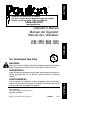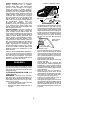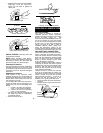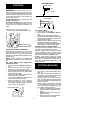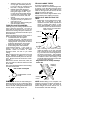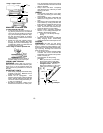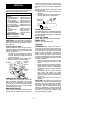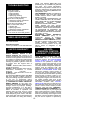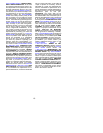
9
S
Be alert to signs that the tree is ready to
fall: cracking sounds, widening of the
felling cut, or movement in the upper
branches.
S
As tree starts to fall, stop saw, put it
down, and get away quick ly on your
planned retreat path.
S
Be extremely cautious with partially fall-
en trees that may be poorly supported.
When atree doesn’t fall completely, set
the saw aside and pull down the tree
with acable winch, block and tackle, or
tractor. To avoidinjury,donot cut down
a partially fallen tree with your saw.
CUTTING A FALLEN TREE
(BUCKING)
Bucking is the term used for cutting a fall-
en tree to the desired log size.
WARNING:
Do not stand onthe log be-
ing cut. Any portion can roll causing loss of
footing and control. Do not stand downhill
of the log being cut.
IMPORTANT POINTS
S
Cut only one log at a time.
S
Cut shattered wood very carefully;
sharppieces ofwood could be flungto-
ward operator.
S
Useasawhorse tocut smalllogs. Never
allow another person to hold the log
while cutting and never hold the log
with your leg or foot.
S
Do not cut in anarea where logs, limbs,
and roots are tangled such as in a
blown down area. Drag the logs into a
clear area before cutting by pulling out
exposed and cleared logs first.
S
Makethe firstbucking cut
1/3
of theway
through the log andfinish witha
2/3
cut
ontheopposite side. As thelog isbeing
cut,itwill tendto bend. Thesawcanbe-
come pinched or hungin the log ifyou
make the first cut deeper than
1/3
of the
diameter of the log.
S
Give special attention to logs under
strainto prevent the saw frompinching.
Make the first cut on the pressure side
to relieve the stress on the log.
TYPES OF CUTTING USED FOR
BUCKING
WARNING:
If saw becomes pinched or
hung in a log, don’t try to force it out. You
canlose control ofthe sawresulting ininjury
and/or damage to the saw. Stop the saw,
driveawedge ofplastic or woodinto thecut
untilthe saw canbe removedeasily. Restart
the saw and carefully reenter the cut. To
avoid kickback and chain damage, do not
use a metal wedge. Do not attempt to re-
start your saw when it is pinched or hung in
alog.
Overcutting
begins on the top side of the
log with the bottom of the saw against the
log. When overcutting use light downward
pressure.
Undercutting
involves cutting on the un-
dersideof thelog withtopofsawagainstthe
log. When undercutting use light upward
pressure. Hold saw firmly and maintain
control. The saw will tend to push back to-
ward you.
Overcutting Undercutting
WARNING:
Never turn saw upside
down to undercut. The saw cannot be con-
trolled in this position.
BUCKING WITHOUT A
SUPPORT
S
Overcut through
1/3
of the diameter of
the log.
S
Roll the log over and finish with a sec-
ond overcut.
S
Watchforlogswith apressure side.See
illustration for cutting logs with a pres-
sure side.
Second cut
First cut on pressure side of log
First cut on pressure side of log
Second cut
BUCKING USING A LOG OR SUP-
PORT STAND
S
Remember your first cut is always on
the pressure side of the log.
(Refer to the illustration below for your
first and second cut)
S
Your first cut should extend
1/3
of the
diameter of the log.
S
Finish with your second cut.
1
st
Cut
2
nd
Cut
Usingalogforsupport
Usingalogforsupport
2
nd
Cut
1
st
Cut



